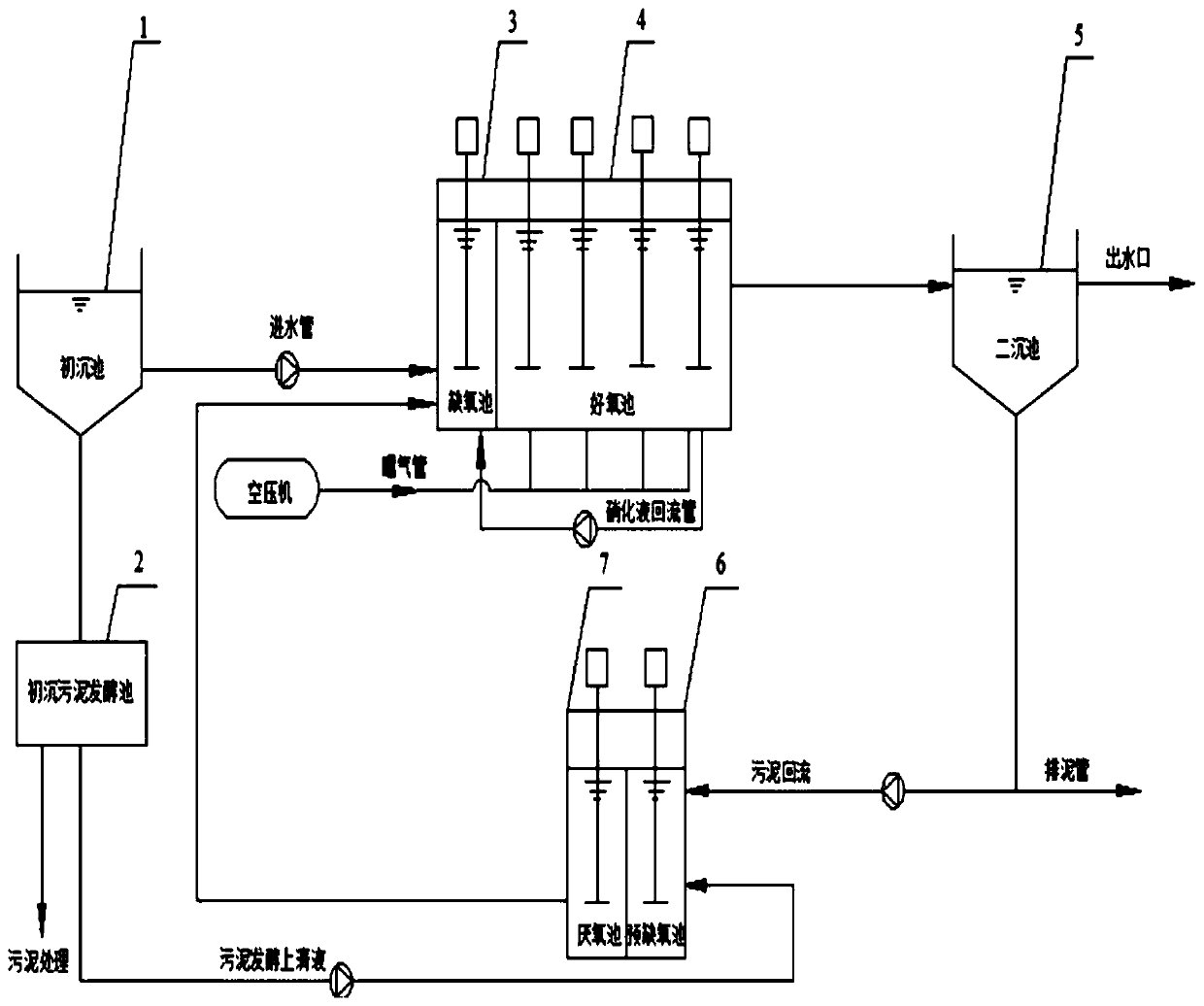Side-flow enhanced biological phosphorus removal process
A biological phosphorus removal and process technology, applied in biological water/sewage treatment, aerobic and anaerobic process treatment, chemical instruments and methods, etc., can solve the problem of reducing phosphorus recovery efficiency in struvite, secondary pollution, and phosphorus accumulation. Bacteria growth and activity inhibition, etc., to achieve the effect of strengthening the performance and stability of nitrogen and phosphorus removal, reducing the demand for fermentation acid production, and shortening the residence time.
- Summary
- Abstract
- Description
- Claims
- Application Information
AI Technical Summary
Problems solved by technology
Method used
Image
Examples
Embodiment 1
[0029] A side-flow enhanced biological phosphorus removal process, including primary sedimentation tank, primary sludge fermentation tank, anoxic tank, aerobic tank, secondary sedimentation tank, side-flow pre-anoxic tank and side-flow anaerobic tank, including the following step:
[0030] Step 1: After the wastewater is introduced into the primary sedimentation tank for deposition, the separated sewage is introduced into the anoxic tank, and the separated sludge is introduced into the primary sludge fermentation tank;
[0031] Step 2: The sewage in the anoxic tank is introduced into the aerobic tank, part of the nitrified sludge water discharged from the aerobic tank is returned to the anoxic tank, and the other part of the nitrified sludge water is introduced into the secondary sedimentation tank;
[0032] Step 3: After the nitrification liquid sludge water in the secondary sedimentation tank is separated from the mud water, the supernatant is discharged, part of the sludge ...
Embodiment 2
[0052] Take the sludge from the return section of a sewage treatment plant, after cleaning and domestication, the process of using this process is as follows:
[0053] The first step: the raw sewage enters the anoxic tank, the COD of the raw sewage is 180mg / L, the total nitrogen (TN) is 30mg / L, the total phosphorus (TP) is 6.8mg / L, the water temperature is 23°C, and the hydraulic retention of the anoxic tank is The time (HRT) is 1.9h, and the sludge concentration is 3500mg / L;
[0054] The second step: the aerobic pool accepts the mud-water mixture discharged from the anoxic pool, the HRT of the aerobic pool is 7.7h, the dissolved oxygen (DO) is greater than 2mg / L, and the reflux ratio of the nitrifying liquid is 300%;
[0055] Step 3: The mud-water mixture discharged from the aerobic tank 4 enters the secondary sedimentation tank for mud-water separation. The sedimentation time of the secondary sedimentation tank is 1.9 hours, and the sludge concentration is 8000mg / L;
[0056...
Embodiment 3
[0060] The first step: the raw sewage enters the anoxic tank, the COD of the raw sewage is 250mg / L, the TN is 40mg / L, the TP is 10mg / L, the water temperature is 23°C, the HRT of the anoxic tank is 1.9h, and the sludge concentration is 3200mg / L L;
[0061] Step 2: The aerobic pool accepts the mud-water mixture discharged from the anoxic pool. The HRT of the aerobic pool is 7.7h, DO is greater than 2.7mg / L, and the reflux ratio of nitrifying liquid is 300%;
[0062] Step 3: The mud-water mixture discharged from the aerobic tank enters the secondary sedimentation tank for mud-water separation. The sedimentation time of the secondary sedimentation tank is 1.9 hours, and the sludge concentration is 8200mg / L;
[0063] Step 4: After the mud-water separation in the secondary settling tank, the supernatant is directly discharged from the system, and the precipitated activated sludge is divided into two parts, one part is discharged from the system as residual sludge, and the other part...
PUM
 Login to View More
Login to View More Abstract
Description
Claims
Application Information
 Login to View More
Login to View More - R&D Engineer
- R&D Manager
- IP Professional
- Industry Leading Data Capabilities
- Powerful AI technology
- Patent DNA Extraction
Browse by: Latest US Patents, China's latest patents, Technical Efficacy Thesaurus, Application Domain, Technology Topic, Popular Technical Reports.
© 2024 PatSnap. All rights reserved.Legal|Privacy policy|Modern Slavery Act Transparency Statement|Sitemap|About US| Contact US: help@patsnap.com








